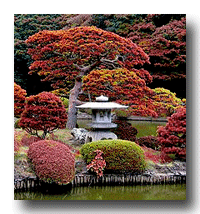Japanese Gardening
The Key to Tranquility

There are essentially two types of Japanese gardens: (1) the tsukiyami, which is a garden mainly composed of hills and ponds, and (2) the hiraniwa, which is the exact opposite of tsukiyami..a flat garden without any hills or ponds.
The basic essentials for you to create a Japanese garden usually includes gravel, rocks, stones, moss, water, hedges, and fences. Rocks are most commonly used as the centerpieces and provide a spiritual-type presence to the garden. According to Shinto tradition, rocks manifest the spirits of nature. Gravel is used as a sort of defining surface and is used to imitate the flow of water when arranged correctly. Stones are used to create a perimeter and are sculpted into the form of lanterns. Water is an essential part, whether it be in the construct of a pond, stream, waterfall, or possibly just portrayed by using gravel, Regardless of the form, water is crucial to a Japanese garden's balance.
There are several forms and types of plants that are signature of this type of gardening, the most popular being the bonsai. Bonsai is the art of dwarfing, or miniaturizing, plants or trees and developing them into an aesthetically pleasing and beautiful shape by growing, pruning, and training them in their own color-coordinated containers. These trees range from five centimeters to one meter ,and retain their small size by being pruned, re-potted, pinched of growth, and having their branches wired.
Japanese gardening is a tradition that has crossed the Muso Soseki, poet, who said, "Gardens are a root of transformation." A Japanese garden is sure to bring about many different feelings and is definitely a transforming experience.
For more garden articles read these
Butterfly gardens
Discount coupons for garden supplies and plants
Koi ponds
Landscaping ideas
Perennials
To Go To Top of Page on Japanese Gardening Click Here
House Tips | Auto Tips | Sports/Hobbies | Grandma's Tips |
Wisdom & Humor |





